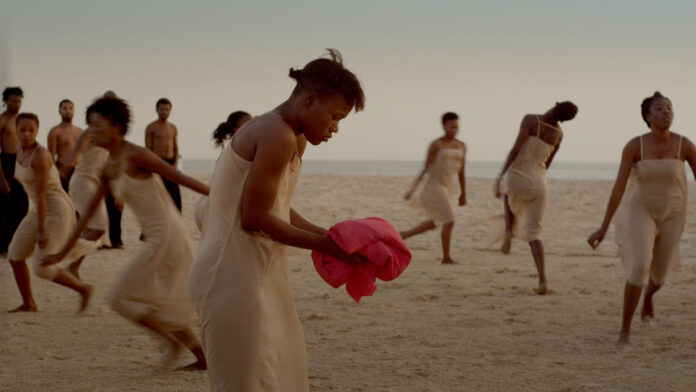Senegal
Mother, godmother, teacher, beacon of the Center International des Danses Africaines Traditionnelles et Contemporaines, this year Germaine Acogny is Artiste Ambassadress du Théâtre de la Ville de Paris and receives the Golden Lion for Lifetime Achievement at the Venice Biennale Danza.
Sensitive to the nature, culture and history of Africa, the new director Wayne McGregor, English with a second home on the island of Lamu in Kenya, has chosen to reward the energy and artistic longevity of a bow figure in the encounter between Europe and Africa. In Venice, Germaine Acogny proposes Somewhere at the Beginning / À un endroit du début, autobiographical solo in which she talks about the bond with the family and the land and dances as a charismatic and exemplary author-interpreter since adolescence.
Germaine Acogny
Originally from Benin (1944), descended from a Yoruba priestess grandmother, with studies in France, implanted in Senegal, Germaine Acogny is the engine of the École des Sables. It was founded in Toubab Dialaw near Dakar in the mid-nineties. There she also operates association-company Jant-B, sole in the Wolof language, at the basis of prominent choreographic projects promoted with her German husband, Helmut Vogt and son, choreographer Patrick at the intersection of multiple cultures. The antecedent was Mudra Afrique, the Pan-African multidisciplinary school, based in Senegal, commissioned by the President-poet Léopold Sédar Senghor with Maurice Béjart in 1977 and placed under the guidance of Acogny itself.
Africa and Germany
Susanne Linke (1944), dancer and choreographer, one of the top personalities of the German Tanztheater, in 1999 created at the École des sables Le coq est mort, the title of a French children’s song but also annoying local rooster singing at all hours of the night, with only male, black, English and French-speaking interpreters, a “political” choice of a multilingual cast that was in itself a victorious diplomatic-artistic achievement.
The dancers themselves created the movement phrases on the sand, initially appearing as Westernized businessmen, equipped with a 24h briefcase, and then revealing themselves as natural African dancers, shirtless, in a powerful and virile dynamic, between black pulsation and music by Shostakovich.
Another occasion of great commitment for the École des sables / Jant Bi was the filming process of the Sacre du Printemps by Pina Bausch with African dancers, started in early 2020 and interrupted by the pandemic, but filmed on Senegalese beaches in the documentary Dancing at Dusk, edited by Florian Heinzen-Ziob.
The dance flows and is transmitted from one continent to another.
Arte africana e dintorni
Senegal
Madre, madrina, maestra, faro del Centre International des Danses Africaines Traditionnelles et Contemporaines, Germaine Acogny quest’anno è Artiste Ambassadrice du Théâtre de la Ville de Paris e riceve il Leone d’Oro alla carriera della Biennale Danza di Venezia.
Sensibile alla natura, cultura e storia dell’Africa, il neodirettore Wayne McGregor, inglese con una seconda casa nell’isola di Lamu in Kenya, ha scelto di premiare l’energia e la longevità artistica di una figura di prua nell’incontro tra Europa e Africa. A Venezia Germaine Acogny propone Somewhere at the Beginning/ À un endroit du début, solo autobiografico dove racconta il legame con la famiglia e la terra e con la danza come autrice-interprete carismatica ed esemplare fin dall’adolescenza.
Germaine Acogny
Originaria del Benin (1944), discendente da una nonna sacerdotessa Yoruba, con studi in Francia, impiantata in Senegal, Germaine Acogny è il motore dell’École des Sables, fondata a Toubab Dialaw presso Dakar a metà degli anni novanta, dove opera anche l’associazione-compagnia Jant-B, sole in lingua wolof, alla base di progetti coreografici di spicco promossi con il marito, tedesco, Helmut Vogt e il figlio coreografo Patrick all’intersezione tra più culture.
L’antecedente era stato il Mudra Afrique, la scuola multidisciplinare panafricana, con sede in Senegal, voluta dal Presidente-poeta Léopold Sédar Senghor con Maurice Béjart nel 1977 e posta sotto la guida della Acogny stessa.
Africa e Germania
Susanne Linke (1944), danzatrice e coreografa, una delle personalità di vertice del Tanztheater tedesco, nel 1999 ha creato all’École des sables Le coq est mort, titolo di una canzoncina infantile francese ma anche molesto gallo locale canterino a tutte le ore della notte, con interpreti solo maschi, neri, anglofoni e francofoni, una scelta “politica” di cast multilingue che è stata di per sé una conquista vittoriosa diplomatico-artistica.
I danzatori stessi hanno creato le frasi di movimento sulla sabbia apparendo inizialmente come uomini d’affari occidentalizzati, muniti di valigetta 24 h, e rivelandosi poi come danzatori africani naturali, a torso nudo, in una dinamica potente e virile, tra pulsazione nera e musica di Shostakovich.
Altra occasione di grande impegno per l’École des sables/Jant Bi è stato il processo di ripresa del Sacre du Printemps di Pina Bausch con danzatori africani avviato agli inizi del 2020 e interrotto per la pandemia, ma filmato sulle spiagge senegalesi nel documentario Dancing at Dusk, a cura di Florian Heinzen-Ziob.
La danza fluisce e si trasmette da un continente all’altro.








